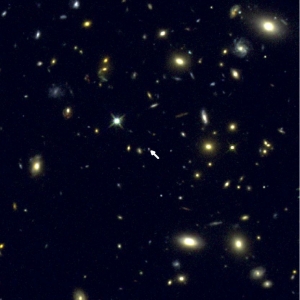Keck Astronomers Look 12 Billion Years Into Past

UCLA astronomers use Keck Observatory to look back 12 billion years and measure oxygen. Galaxy COSMOS-1908 is in the center of this Hubble Space Telescope image, indicated by the arrow. Nearly everything in the image is a galaxy. CREDIT: RYAN SANDERS AND THE CANDELS TEAM
UCLA astronomers have used the W.M. Keck Observatory on Maunakea to make the first accurate measurement of the abundance of oxygen in a distant galaxy.
Oxygen, the third-most abundant chemical element in the universe, is created inside stars and released into interstellar gas when stars die.
Quantifying the amount of oxygen is key to understanding how matter cycles in and out of galaxies.
This research is published online in the Astrophysical Journal Letters.
“This is by far the most distant galaxy for which the oxygen abundance has actually been measured,” said Alice Shapley, a UCLA professor of astronomy, and co-author of the study. “We’re looking back in time at this galaxy as it appeared 12 billion years ago.”
Knowing the abundance of oxygen in the galaxy called COSMOS-1908 is an important stepping stone toward allowing astronomers to better understand the population of faint, distant galaxies observed when the Universe was only a few billion years old, Shapley said.
COSMOS-1908 contains approximately one billion stars. In contrast, the Milky Way contains approximately 100 billion stars. Furthermore, COSMOS-1908 contains approximately only 20% of the abundance of oxygen that is observed in the sun.
Typically, astronomers rely on extremely indirect and imprecise techniques for estimating oxygen abundance for the vast majority of distant galaxies. But in this case, UCLA researchers used a direct measurement, said Ryan Sanders, astronomy graduate student and the study’s lead author.
“Close galaxies are much brighter, and we have a very good method of determining the amount of oxygen in nearby galaxies,” Sanders said.
In faint, distant galaxies, the task is dramatically more difficult, but COSMOS-1908 was one case for which Sanders was able to apply the “robust” method commonly applied to nearby galaxies. “We hope this will be the first of many.”
Shapley said that prior to Sanders’ discovery, researchers didn’t know if they could measure how much oxygen there was in these distant galaxies.
Keck Observatory’s MOSFIRE collects visible-light photons from objects billions of light years away whose wavelengths have been stretched or “redshifted” to the infrared by the expansion of the universe.
Due to the finite speed of light, MOSFIRE is providing a view of these galaxies as they existed billions of years ago, when the light first started traveling to Earth.
MOSFIRE is a type of instrument known as a “spectrograph,” which spreads the light from astronomical objects out into a spectrum of separate wavelengths (colors), indicating the specific amount of energy emitted at each wavelength.
Spectrographs enable astronomers to determine the chemical contents of galaxies, because different chemical elements—such as oxygen, carbon, iron or hydrogen—each provide a unique spectral fingerprint, emitting light at specific wavelengths.
To characterize the chemical contents of COSMOS-1908, Sanders analyzed a particular wavelength in the MOSFIRE spectrum of this galaxy that is sensitive to the amount of oxygen.
“It’s an amazing instrument, which made Ryan’s measurement possible,” Shapley said.
To read the entire report, go online.
The W.M. Keck Observatory operates the largest, most scientifically productive telescopes on Earth. The two, 10-meter optical/infrared telescopes near the summit of Maunakea on the Island of Hawaii feature a suite of advanced instruments including imagers, multi-object spectrographs, high-resolution spectrographs, integral-field spectrographs and world-leading laser guide star adaptive optics systems.
Keck Observatory is a private 501(c) 3 nonprofit organization and a scientific partnership of the California Institute of Technology, the University of California and NASA.













